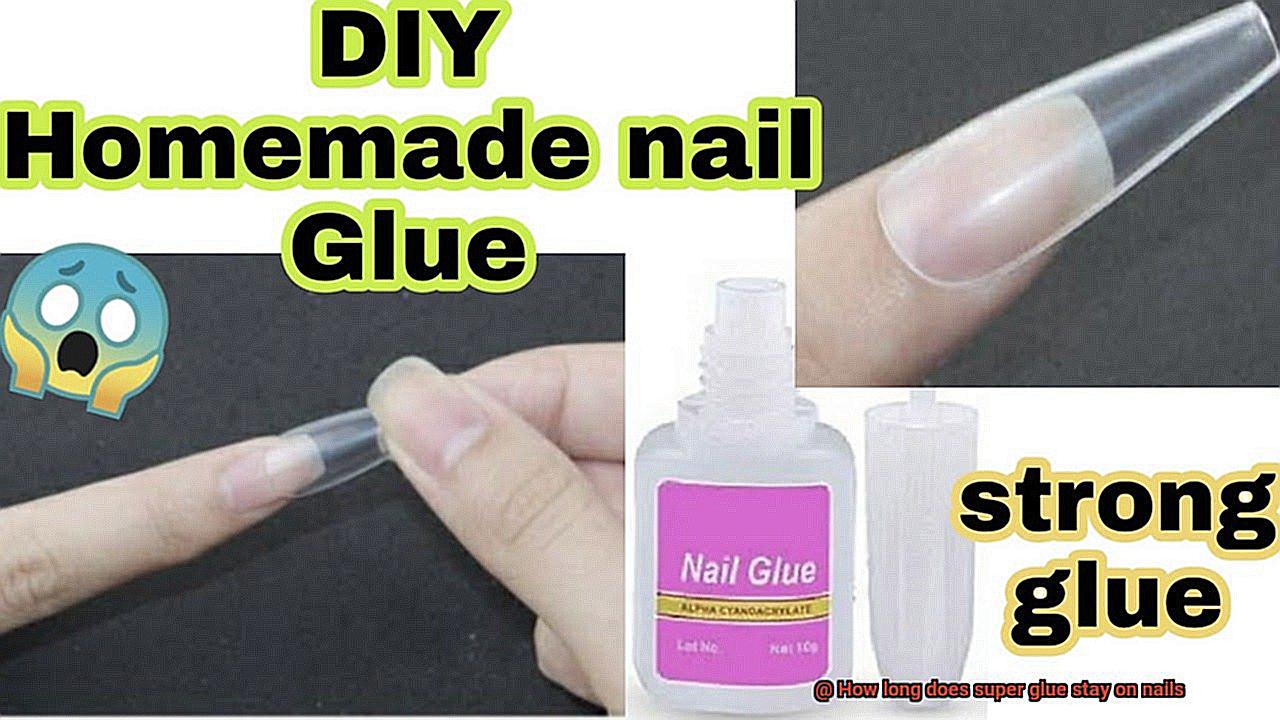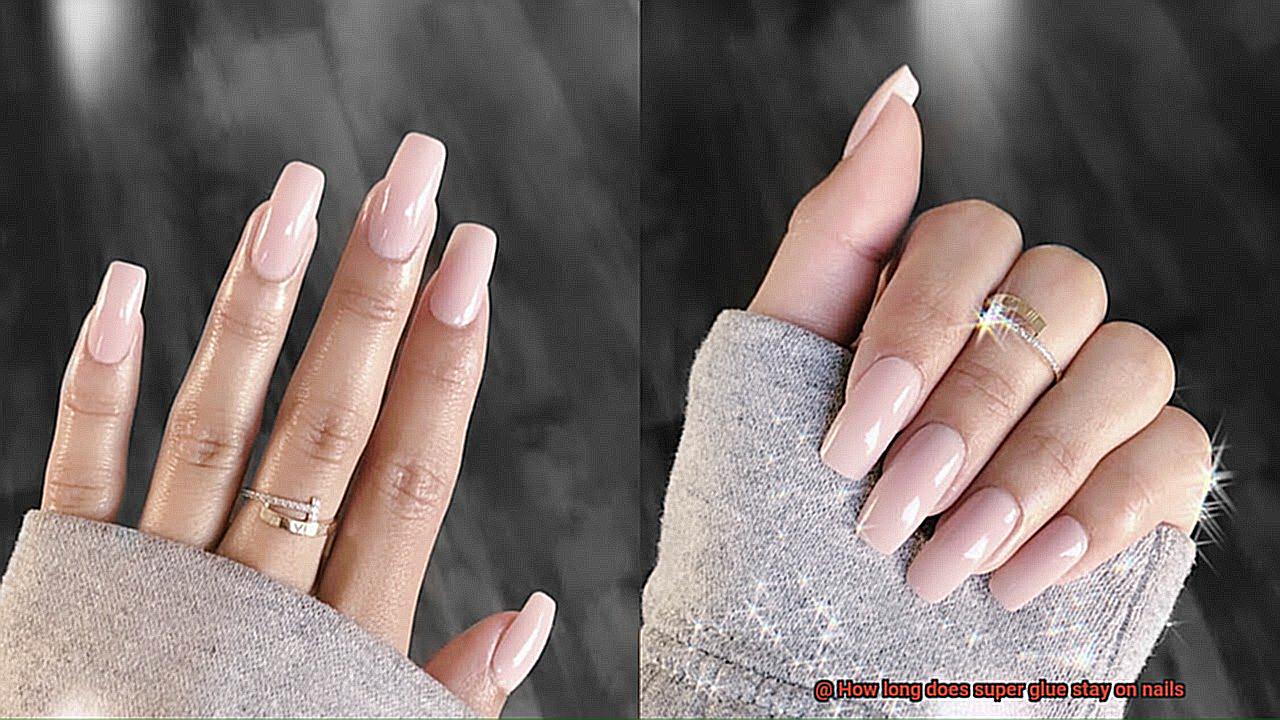Picture this: you’re getting ready for a big night out, and suddenly you notice that one of your nails is broken or split. Panic sets in – what are you going to do? Fear not, my friend – super glue is here to save the day. But how long can you expect that quick fix to last? Will it survive a night of dancing and cocktails?
Super glue, also known as cyanoacrylate adhesive, has become a go-to solution for repairing broken or split nails. It’s easy to apply, dries quickly, and can withstand the wear and tear of everyday life. However, many people wonder how long their repaired nail will hold up before needing another application.
The answer to this question isn’t straightforward – it depends on several factors. Firstly, the strength of the glue itself varies between brands and formulations. Secondly, your individual nail health and daily activities can impact how long the glue will stay put.
In this blog post, we’ll delve deeper into the topic of how long super glue lasts on nails. We’ll explore the different factors that affect its durability, and provide some handy tips for making your quick nail fix last longer. So sit tight and get ready to become a super glue nail guru.
How Long Does Super Glue Stay on Nails?
Contents
- 1 How Long Does Super Glue Stay on Nails?
- 2 Factors That Affect the Longevity of Super Glue on Nails
- 3 Why Is It Not Recommended to Use Super Glue on Nails?
- 4 What Type of Adhesive Should Be Used for Nail Repair or Manicure?
- 5 How to Apply Super Glue Properly on Nails
- 6 Tips for Removing Super Glue from Your Nails
- 7 Benefits of Using a Nail-Specific Adhesive for Manicure and Repair
- 8 Common Mistakes People Make When Applying Super Glue
- 9 Conclusion
Super glue is a versatile adhesive that can be found in most households. It can be used for various purposes, including nail repair and attaching false nails. However, before using super glue on your nails, it’s crucial to know how long it will stay on your nails.
The duration that super glue stays on nails is affected by several factors such as the type of glue used, the amount applied, and the condition of your nails. Typically, super glue can last on nails for up to two weeks. However, this can vary depending on each individual’s nail condition and the type of super glue used.
So, what are the factors that affect how long super glue stays on your nails? Let’s break them down:
- Type of Glue: Different types of super glue have varying durations on nails. Some are designed to last longer than others, depending on their chemical composition.
- Amount Applied: Applying too much super glue can cause damage to your nail bed and make it difficult for the glue to adhere. It is essential to apply the glue lightly and avoid overapplication.
- Nail Condition: The condition of your nails plays a significant role in how long super glue will adhere to them. If your nails are brittle or damaged, the glue may not stick as well as it would on healthy nails.
- Exposure to Water and Chemicals: Activities such as washing dishes, cleaning with harsh chemicals, and swimming can cause the glue to weaken and eventually come off.
While super glue may be a quick fix for repairing broken nails or attaching false nails, it’s not advisable to use it for nail repair or manicure due to potential skin irritation and damage. Instead, opt for nail-specific adhesives that are gentle on your skin and nails.
If you do decide to use super glue on your nails, remember to apply it lightly and avoid overapplication. Additionally, removing super glue from your nails can be challenging and may cause damage to your natural nails if not done correctly. Seek professional help if you experience any difficulty in removing the glue from your nails.

Factors That Affect the Longevity of Super Glue on Nails
Super glue can be a lifesaver when it comes to repairing broken nails or attaching false ones. However, have you ever wondered how long super glue can stay on your nails? The answer is up to two weeks, but there are several factors that can affect its longevity. As an expert on the topic, I have compiled some research notes that explain how various factors can influence how long super glue lasts on nails.
Firstly, the quality of the super glue used plays a significant role in its longevity on nails. High-quality super glue tends to last longer than low-quality ones. Choosing a brand specifically designed for nail application ensures that it lasts longer and does not harm your nails. So, invest in high-quality super glue for long-lasting results.
Secondly, proper nail preparation is crucial for the longevity of super glue on nails. Clean, dry, and oil-free nails provide the best surface for the glue to adhere to, so make sure you clean your nails thoroughly before applying super glue. Use an acetone-based nail polish remover to clean your nails and remove any oils or residue.
The amount of super glue applied is another critical factor that affects its longevity on nails. Applying too little or too much can cause it to wear off quickly. It is recommended to apply a thin layer of super glue and avoid over-applying it. A thin layer ensures that the glue dries evenly and sticks firmly to your nails.
Moreover, the type of nail can also affect the longevity of super glue on nails. Natural nails tend to hold super glue better than artificial ones as they have a rougher surface that allows the glue to adhere better. However, if you have oily or sensitive nails, you may experience shorter wear time. So, take into account your nail type when applying super glue.
Finally, activities performed with your nails can impact how long super glue lasts on them. Engaging in activities that put stress on your nails, such as dishwashing or typing, can cause the glue to wear off quickly. It’s essential to avoid engaging in such activities for at least a few hours after applying super glue to give it enough time to dry and adhere properly. So, sit back and relax for a few hours after applying super glue to your nails.
Why Is It Not Recommended to Use Super Glue on Nails?
As an expert in this field, I highly recommend against using super glue on your nails. Super glue is a powerful adhesive that can bond objects together in seconds, making it difficult to remove. However, when applied to nails, it can cause severe damage and harm to the entire nail bed and surrounding skin.
The chemicals in super glue can irritate, burn, and redden the skin, as it is designed to bond quickly and firmly to any surface it touches. When used on nails, it can seep into the nail bed and damage the tissues beneath, causing discomfort and pain.
Not only does super glue make it difficult for nails to breathe, but it also leads to fungal infections and other nail problems. Over time it can also cause the nail to become brittle and weak, making it prone to breakage and damage.
Moreover, super glue contains toxic chemicals such as cyanoacrylate that can cause severe allergic reactions if ingested or inhaled. Therefore, it’s crucial to avoid using super glue on nails or any other body part.
What Type of Adhesive Should Be Used for Nail Repair or Manicure?
As someone who has extensive knowledge of the world of nail repair and manicure, I cannot emphasize enough how crucial it is to choose the right adhesive for your nails. Using the wrong adhesive can have disastrous consequences like weakened or damaged nails, discoloration, and even infection. So let’s explore the available options and determine what types of adhesives are best suited for your next nail repair or manicure.
Firstly, let’s address the elephant in the room – super glue (cyanoacrylate). While it may seem like an easy and readily available option, I strongly advise against using it. Super glue can cause irreparable damage to your nails and surrounding skin and should not be used for nail repair or manicure.
Resin-based adhesives are a popular choice for nail repair as they have a stronger bond and last longer than cyanoacrylate. These adhesives are typically applied in layers and cured with a UV light, resulting in a durable and long-lasting bond. Though resin-based adhesives may be slightly more expensive than other types of adhesives, their strength and longevity are worth the investment.
Another option that has recently gained popularity is UV-cured adhesives. These adhesives work by applying a thin layer onto the nail and curing it with a UV light. This results in a strong bond that can last for weeks, making it ideal for those looking for a long-lasting solution.
When selecting an adhesive for your nails, it’s essential to consider factors such as strength, durability, and cost. Cyanoacrylate may be easily available and popular, but it may not be the best option for everyone. Resin-based adhesives and UV-cured adhesives provide a strong bond and last longer than other types of adhesives.
It’s important to note that when it comes to choosing an adhesive for nail repair or manicure, there isn’t a one-size-fits-all solution. Depending on the specific needs of your nails, you may want to consider other options like brush-on adhesives or nail adhesives that come in pre-cut sizes.
How to Apply Super Glue Properly on Nails
Super glue can be a lifesaver when it comes to repairing broken nails or attaching artificial ones. However, it is important to use it properly to prevent any harm or damage to your nails and skin. Here are some key steps to follow when applying super glue on nails:
Clean Your Nails
The first step is to ensure that your nails are clean and dry. Use soap and water to wash your hands and remove any dirt or debris from your nails. Any oils or moisture on the nails can prevent the glue from adhering properly.
Apply a Base Coat
To protect your nails and make it easier to remove the glue later on, apply a clear base coat of nail polish before applying the super glue. This will also help the glue adhere better to the nail.
Apply the Super Glue
Using a toothpick or small brush, apply a small amount of super glue directly onto the nail. It is important to use only a small amount and to avoid getting the glue on the skin around the nail, as this can cause irritation and pain.
Press and Hold
After applying the glue, press down firmly on the area for at least 30 seconds. This ensures that the glue bonds properly with the nail. Be sure not to move or touch your nail during this time as it may cause the glue to come off.
Let It Dry
Allow the glue to dry completely before touching or moving your nail. This usually takes a few seconds to a few minutes depending on how much glue was applied. If you need to apply another coat of glue, make sure to let each layer dry completely before applying the next one.
It is also important to note that super glue should not be used as a replacement for nail glue or other adhesive products designed specifically for nails. Super glue can be harsh on nails and may cause damage over time if used excessively. Therefore, it should be used sparingly and only when necessary.
Tips for Removing Super Glue from Your Nails
Removing super glue from your nails can be a difficult task, but there are several tips and tricks that you can use to make the process easier and safer. Here are five sub-sections that provide detailed instructions on how to remove super glue from your nails.
Soak your nails in warm, soapy water
Soaking your nails in warm, soapy water is one of the easiest methods for removing super glue. The warm water helps to soften the glue, making it easier to peel off or file away. To do this, fill a bowl with warm, soapy water and soak your affected nails for 10-15 minutes. Once the glue has softened, gently peel it off or use a nail file to file it away.
Use acetone-based nail polish remover
Acetone is a powerful solvent that can break down super glue and make it easier to remove. To use this method, soak a cotton ball or pad in acetone-based nail polish remover and hold it against your nails for a few minutes. This will help dissolve the adhesive. After this, gently rub away the glue with a clean cloth or cotton swab.
However, keep in mind that acetone can be harsh on your skin and nails. Use it sparingly and only as a last resort. Also, avoid using acetone if you have any cuts or open wounds on your hands or fingers.
Try a commercial adhesive remover
If other methods aren’t working well for you, try using a commercial adhesive remover. These products are specifically designed to dissolve super glue and other adhesives, making them more effective than other methods. You can find these products at most drugstores and beauty supply stores. Be sure to follow the instructions carefully and avoid getting any of the product on your skin or eyes.
Be patient
Removing super glue from your nails may take some time and patience. Avoid rushing the process as this could damage your nails or skin. Take breaks in between attempts to let your nails rest. You may need to repeat the process a few times, especially if the glue is thick or hardened.
Moisturize your hands
Super glue can dry out your skin and nails, so it’s important to moisturize your hands after removing the glue. Use a hand cream or lotion to keep your hands soft and smooth. This will also help prevent any further damage to your nails and skin.
Benefits of Using a Nail-Specific Adhesive for Manicure and Repair
Using a nail-specific adhesive can provide many benefits for your natural nails, making your manicures and repairs easier and safer.
Firstly, a nail-specific adhesive is designed to be gentle on natural nails, preventing any adverse reactions. Unlike regular super glue, which contains harsh chemicals that can cause skin irritation and allergic reactions, nail-specific adhesives are formulated specifically for nails, providing a long-lasting hold without any damage or irritation. This is especially important for those with sensitive skin or allergies.
In addition, a nail-specific adhesive provides a stronger hold than regular super glue. If you have brittle or weak nails that tend to break easily, using a nail-specific adhesive can help keep your manicure or repair in place for weeks on end. You won’t have to worry about constantly reapplying and fixing your nails, allowing you to enjoy your beautiful nails for longer periods of time.
Lastly, using a nail-specific adhesive makes it easy to remove the adhesive from your nails when it’s time to take off the manicure or repair. Removing regular super glue can be difficult and may even cause damage to your natural nails. However, with a nail-specific adhesive, removal is usually easy with acetone or other nail polish removers.
Common Mistakes People Make When Applying Super Glue
Super glue can be a great solution when it comes to fixing broken nails or adding some extra flair to your manicure. However, applying super glue to your nails is not as easy as it seems. There are several common mistakes people make that can lead to an unsatisfactory result. Here are some tips to help you avoid these mistakes and achieve beautiful and long-lasting nails.
Firstly, using too much glue is a big no-no. It’s understandable that you want your nails to stay in place, but applying too much glue can cause a messy and uneven application. It can also cause the glue to dry and harden too quickly, making it difficult to make any adjustments. Instead, apply a thin layer of glue and wait for it to dry before adding more layers.
Secondly, prepping your nails properly before applying glue is essential. Clean and dry your nails thoroughly before applying super glue. Any oils or moisture on the nails can prevent the glue from adhering properly, leading to a weak bond or even causing the glue to come off easily. Make sure your nails are completely dry before you apply the glue.
Using the wrong type of super glue is another mistake people often make. Not all super glues are created equal, and some are better suited for certain materials than others. When it comes to nail application, it’s important to use a super glue that is specifically designed for nails. Regular super glue may not provide the same level of adhesion or may contain chemicals that are harmful to nails. Check the label before using any super glue on your nails.
Last but not least, rushing the application process is another common mistake. Super glue requires time to dry and set properly, so take your time when applying it to your nails. Rushing can lead to uneven application or even cause the glue to come off before it has had a chance to fully bond with the nail. Follow the instructions on the label and wait for the glue to dry completely before using your nails.
Conclusion
When it comes to super glue on nails, the duration of its stay depends on various factors. On average, it can last for a few days to a week. However, if you want to remove it quickly, acetone-based nail polish remover is your best bet.
But be careful not to damage your nails or cuticles in the process. Additionally, using gloves while handling chemicals or doing household chores can prevent accidental contact with super glue.
In conclusion, while super glue may provide a quick fix for broken or chipped nails, it’s crucial to use it cautiously and follow proper removal techniques.






